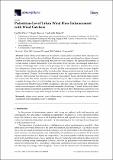| dc.contributor.author | Nazarian, Negin | |
| dc.contributor.author | Chew, Lup Wai | |
| dc.contributor.author | Norford, Leslie Keith | |
| dc.date.accessioned | 2017-11-01T17:09:27Z | |
| dc.date.available | 2017-11-01T17:09:27Z | |
| dc.date.issued | 2017-08 | |
| dc.date.submitted | 2017-07 | |
| dc.identifier.issn | 2073-4433 | |
| dc.identifier.uri | http://hdl.handle.net/1721.1/112110 | |
| dc.description.abstract | Dense urban areas restrict air movement, causing airflow in urban street canyons to be much lower than the flow above buildings. Boosting near-ground wind speed can enhance thermal comfort in warm climates by increasing skin convective heat transfer. We explored the potential of a wind catcher to direct atmospheric wind into urban street canyons. We arranged scaled-down models of buildings with a wind catcher prototype in a water channel to simulate flow across two-dimensional urban street canyons. Velocity profiles were measured with Acoustic Doppler Velocimeters. Experiments showed that a wind catcher enhances pedestrian-level wind speed in the target canyon by 2.5 times. The flow enhancement is local to the target canyon with little effect in other canyons. With reversed flow direction, a “reversed wind catcher” has no effect in the target canyon but reduces the flow in the immediate downstream canyon. The reversed wind catcher exhibits a similar blockage effect of a tall building amid an array of lower buildings. Next, we validated Computational Fluid Dynamics (CFD) simulations of all cases with experiments and extended the study to reveal impacts on three-dimensional ensembles of buildings. A wind catcher with closed sidewalls enhances maximum pedestrian-level wind speed in three-dimensional canyons by four times. Our results encourage better designs of wind catchers to increase wind speed in targeted areas. | en_US |
| dc.publisher | MDPI AG | en_US |
| dc.relation.isversionof | http://dx.doi.org/10.3390/atmos8090159 | en_US |
| dc.rights | Creative Commons Attribution | en_US |
| dc.rights.uri | http://creativecommons.org/licenses/by/4.0/ | en_US |
| dc.source | Multidisciplinary Digital Publishing Institute | en_US |
| dc.title | Pedestrian-Level Urban Wind Flow Enhancement with Wind Catchers | en_US |
| dc.type | Article | en_US |
| dc.identifier.citation | Chew, Lup et al. "Pedestrian-Level Urban Wind Flow Enhancement with Wind Catchers." Atmosphere, 8, 9 (August 2017): 159 © 2017 The Authors | en_US |
| dc.contributor.department | Massachusetts Institute of Technology. Department of Architecture | en_US |
| dc.contributor.department | Massachusetts Institute of Technology. Department of Mechanical Engineering | en_US |
| dc.contributor.mitauthor | Chew, Lup Wai | |
| dc.contributor.mitauthor | Norford, Leslie Keith | |
| dc.relation.journal | Atmosphere | en_US |
| dc.eprint.version | Final published version | en_US |
| dc.type.uri | http://purl.org/eprint/type/JournalArticle | en_US |
| eprint.status | http://purl.org/eprint/status/PeerReviewed | en_US |
| dc.date.updated | 2017-10-25T15:58:37Z | |
| dspace.orderedauthors | Chew, Lup; Nazarian, Negin; Norford, Leslie | en_US |
| dspace.embargo.terms | N | en_US |
| dc.identifier.orcid | https://orcid.org/0000-0003-2225-1057 | |
| dc.identifier.orcid | https://orcid.org/0000-0002-5631-7256 | |
| mit.license | PUBLISHER_CC | en_US |
| mit.metadata.status | Complete | |
